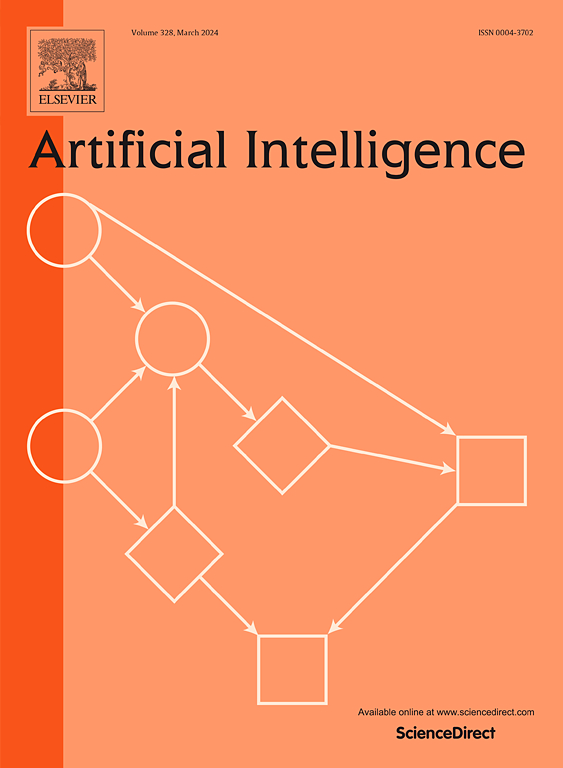单数据点的IID预测不等式
IF 4.6
2区 计算机科学
Q1 COMPUTER SCIENCE, ARTIFICIAL INTELLIGENCE
引用次数: 0
摘要
在这项工作中,我们研究了单选择先知不等式问题,其中卖家遇到n个在线出价序列。这些出价被建模为来自未知分布的独立和同分布(i.i.d)随机变量。在每个投标的价值被披露后,卖方必须立即做出是否接受投标并将物品出售给投标人的不可撤销的决定。目标是使卖方的预期收益与最高出价之间的竞争比率最大化。Correa et al.[1]表明,当分布未知或只给出o(n)个均匀样本时,算法的最佳性能是1/e竞争。而当分布已知[2]时,或给定Ω(n)个均匀样本[3]时,最优竞争比为0.7451。本文从历史销售数据中,研究了当销售者可以访问分布的累积密度函数中的单个点时的设置。我们将研究如何有效地利用这些数据点来设计竞争性算法。受秘书问题算法的启发,我们提出了一种观察-接受算法,该算法在第一阶段使用数据点设置阈值,并采用第一阶段的最高出价作为第二阶段的阈值。它可以看作是先知不等式的单阈值算法与秘书问题算法的自然结合。我们表明,我们的算法在广泛的数据点范围内实现了良好的竞争比,在某些数据点n→∞时达到了0.6785的竞争比。此外,我们研究了一种使用两个以上阶段的算法的扩展,并表明竞争比可以进一步提高到至少0.6862。本文章由计算机程序翻译,如有差异,请以英文原文为准。
IID prophet inequality with a single data point
In this work, we study the single-choice prophet inequality problem, where a seller encounters a sequence of n online bids. These bids are modeled as independent and identically distributed (i.i.d.) random variables drawn from an unknown distribution. Upon the revelation of each bid's value, the seller must make an immediate and irrevocable decision on whether to accept the bid and sell the item to the bidder. The objective is to maximize the competitive ratio between the expected gain of the seller and that of the maximum bid. It is shown by Correa et al. [1] that when the distribution is unknown or only uniform samples from the distribution are given, the best an algorithm can do is -competitive. In contrast, when the distribution is known [2], or when uniform samples are given [3], the optimal competitive ratio of 0.7451 can be achieved. In this paper, we study the setting when the seller has access to a single point in the cumulative density function of the distribution, which can be learned from historical sales data. We investigate how effectively this data point can be used to design competitive algorithms. Motivated by the algorithm for the secretary problem, we propose the observe-and-accept algorithm that sets a threshold in the first phase using the data point and adopts the highest bid from the first phase as the threshold for the second phase. It can be viewed as a natural combination of the single-threshold algorithm for prophet inequality and the secretary problem algorithm. We show that our algorithm achieves a good competitive ratio for a wide range of data points, reaching up to 0.6785-competitive as for certain data points. Additionally, we study an extension of the algorithm that utilizes more than two phases and show that the competitive ratio can be further improved to at least 0.6862.
求助全文
通过发布文献求助,成功后即可免费获取论文全文。
去求助
来源期刊

Artificial Intelligence
工程技术-计算机:人工智能
CiteScore
11.20
自引率
1.40%
发文量
118
审稿时长
8 months
期刊介绍:
The Journal of Artificial Intelligence (AIJ) welcomes papers covering a broad spectrum of AI topics, including cognition, automated reasoning, computer vision, machine learning, and more. Papers should demonstrate advancements in AI and propose innovative approaches to AI problems. Additionally, the journal accepts papers describing AI applications, focusing on how new methods enhance performance rather than reiterating conventional approaches. In addition to regular papers, AIJ also accepts Research Notes, Research Field Reviews, Position Papers, Book Reviews, and summary papers on AI challenges and competitions.
 求助内容:
求助内容: 应助结果提醒方式:
应助结果提醒方式:


